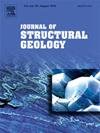Quartz microstructures and crystallographic preferred orientation analysis across the Himalayan metamorphic core reveal exhumation through changing taper angle and strain partitioning along discreet fault zones
IF 2.9
2区 地球科学
Q2 GEOSCIENCES, MULTIDISCIPLINARY
引用次数: 0
Abstract
The Himalayan metamorphic core in the Bhagirathi Valley of North India comprises three major tectonic zones: the Main Central Thrust zone (MCTz) that separates the Paleoproterozoic Lesser Himalayan Crystalline rocks from the Proterozoic to Cambro-Ordovician Greater Himalayan Sequence; the High Himalayan Discontinuity (HHD) that separates the lower inverted metamorphic sequence from the upper anatectic part of the GHS; and the Jhala Normal Fault (JNF) that marks the northernmost boundary of this metamorphic core. Quartz microstructural analyses across this metamorphic core indicate that dynamic recrystallization at lower temperatures overprinted the high-temperature deformation features, also evident from dominant prism<a> slip in quartz. Strength of quartz crystallographic preferred orientation (CPO) is also highest at these locations. Vorticity analysis suggests simple shear partitioning in the JNF and MCTz, with pure shear in other parts. It is concluded that the exhumation of the Himalayan metamorphic core was facilitated by simple shear along the JNF and MCTz, with thrust propagation south of MCTz compensating for changes in the taper angle of the Himalayan wedge due to activity along the JNF.
喜马拉雅变质岩心的石英显微结构和晶体学优选取向分析揭示了沿离散断裂带改变锥度角和应变分配的挖掘作用
北印度Bhagirathi山谷喜马拉雅变质岩心包括三个主要构造带:主中央逆冲带(MCTz)将古元古代小喜马拉雅结晶岩与元古代至寒武系-奥陶系大喜马拉雅层序分开;高喜马拉雅间断面(HHD)分隔了GHS下部倒转变质层序和上部非纯岩部分;以及标志着这个变质核最北端边界的Jhala正断层(JNF)。对该变质岩心的石英显微结构分析表明,低温下的动态再结晶叠加了高温变形特征,这一点在主要棱柱中也很明显。在石英中滑动。石英晶体优先取向(CPO)的强度在这些位置也是最高的。涡度分析表明,在JNF和MCTz中存在简单的剪切分配,其他部分存在纯粹的剪切分配。因此,喜马拉雅变质岩心的挖掘是由沿JNF和MCTz的简单剪切作用促进的,MCTz以南的逆冲传播补偿了沿JNF活动引起的喜马拉雅楔体锥度角的变化。
本文章由计算机程序翻译,如有差异,请以英文原文为准。
求助全文
约1分钟内获得全文
求助全文
来源期刊

Journal of Structural Geology
地学-地球科学综合
CiteScore
6.00
自引率
19.40%
发文量
192
审稿时长
15.7 weeks
期刊介绍:
The Journal of Structural Geology publishes process-oriented investigations about structural geology using appropriate combinations of analog and digital field data, seismic reflection data, satellite-derived data, geometric analysis, kinematic analysis, laboratory experiments, computer visualizations, and analogue or numerical modelling on all scales. Contributions are encouraged to draw perspectives from rheology, rock mechanics, geophysics,metamorphism, sedimentology, petroleum geology, economic geology, geodynamics, planetary geology, tectonics and neotectonics to provide a more powerful understanding of deformation processes and systems. Given the visual nature of the discipline, supplementary materials that portray the data and analysis in 3-D or quasi 3-D manners, including the use of videos, and/or graphical abstracts can significantly strengthen the impact of contributions.
 求助内容:
求助内容: 应助结果提醒方式:
应助结果提醒方式:


